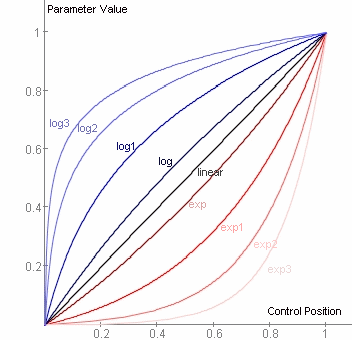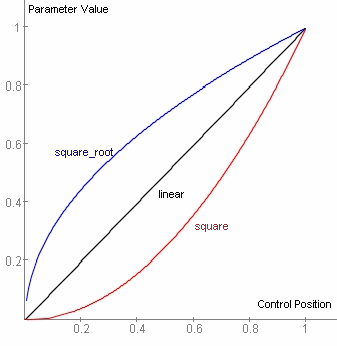
Here is the list of all types of values for the attributes of the elements of Blue Cat's skinning language.
| Type | Syntax | Examples | Comment |
|---|---|---|---|
|
Any alphanumeric or '_' character, without space. |
'myControl', 'slider1','param_slider' |
'my Control' is an invalid identifier since it contains a space character. |
|
|
Any character |
Hello! |
|
|
|
RGB hexadecimal value preceded by '#' |
'#ffffff' for white, '#ff0000' for red. |
This is the same syntax as HTML colors. |
|
|
'true' or 'false' |
|
|
|
|
digits.digits |
'5.3' '10' '3.02' '0.4' |
The language only supports English notation with '.' as delimiter. |
|
|
'real' or 'boolean' or 'integer' |
|
Real stands for real number in floating point notation (5.3) |
|
|
Any positive integer value |
145 |
|
|
|
Real number followed by '%' |
'20%' '33.3%' |
|
|
|
Any integer value |
-5 |
|
|
|
'top' or 'bottom' or 'center' |
|
|
|
|
'left' or 'right' or 'center' |
|
|
|
|
'vertical' or 'horizontal' |
'vertical' |
|
|
|
'curve' or 'bargraph' |
'bargraph' |
The bargraph style displays bars from the origin of the graph to the value of the curve, whereas the curve style draws curve points connected by segments in the case of non continuous curves. |
|
|
'solid', 'dash', 'dot', 'dash_dot' or 'dash_dot_dot' |
'dash_dot' |
|
|
|
Relative file path. The root of all paths is the skin file directory. |
'xxx.bmp', or 'images\xxx.bmp' |
|
|
|
See file path |
|
Supported formats: bmp (8,16 or 24 bits). For more information see the about images section. |
|
|
Valid cursor path or 'system::xxx' where xxx is a valid cursor type. |
System::hand or 'mycursor.cur' |
For more information, see the about cursors section |
|
|
dsp.inputxxx or dsp.outputxxx where xxx is the parameter index (from 0 to number of parameters-1). (inputxxx or outputxxx for v1.0), or 'yyyy.zzzz' where 'zzzz' is the name of an exposed parameter of the 'yyyy' object. |
'input0' or 'output3' |
The parameters list of the plug-in is usually available in the plug-in documentation. If not the parameters can be seen in the host automation properties. |
|
|
dsp.output_curvexxx where xxx is the curve index (from 0 to number of curve-1) |
'output_curve0' |
The curves list of the plug-in is available in the plug-in documentation. |
|
|
String containing fields enclosed into brackets |
'the value is: {value} {unit}' |
Valid fields are the following: {value}, {unit}, {name}, {default}, {min}, {max}, {comment} and (V1.3.4) {text_value} |
|
|
Flag|max_char|.digits (all fields are optional), where: Flag values (can be mixed):
max_char is the maximum number of characters to use for the text (sign and '.' included) '.' followed by digits: number of characters reserved for the decimal part |
'+8.2' will show a number with its sign, with a maximum of 8 characters (including '.') and 2 characters reserved for the digits '.0' will show a number without decimal part. '+05.0' will show a value with 5 characters without any decimal part, padded with '0' if needed. |
Using the max_char field avoids the text to move on the screen when the value changes if you used a fixed size font such as 'Courier New'. For programmers, the syntax is very similar to the formatting options of 'printf' standard c function.
|
|
|
A value in this list: 'linear' 'log' 'exp' 'log1' 'exp1' 'log2' 'exp2' 'log3' 'exp3' 'square_root' 'square' |
|
See the graphes below for a more explicit view of the different curves. |


The Language supports mathematical formulas for several purposes (attributes computation, curves or surfaces defined with formulas etc.). The syntax is similar to common mathematical notations on computer systems. Example:
3*x^2+cos(pi/2)*x+1
The language supports most common operators (*,/,+,-,^) as well as several predefined mathematical functions. The complete list is available below:
| Symbol | Operation | Example | Comment |
|---|---|---|---|
|
+ |
Addition |
x+1 |
|
|
* |
Multiplication |
x*y |
|
|
- |
Substraction |
5-z |
|
|
/ |
Division |
x/2 |
|
|
^ |
Power |
a^2 represents "a square" |
|
|
% |
Modulo |
x%5 means "x modulo 5" |
|
|
== |
Equals |
a==b means "a equals b" and the result is true or false |
You can also use '=' |
|
!= |
Not Equals |
a!=b means "a does not equal b" and the result is true or false |
You can also use '<>' |
|
< |
Lower than |
a<b means "a stricly lower than b" and the result is true or false |
|
|
> |
Greater than |
a>b means "a stricly greater than b" and the result is true or false |
|
|
<= |
Lower than or equal |
a<=b means "a lower than or equal to b" and the result is true or false |
|
|
>= |
Greater than or equal |
a>=b means "a greater than or equal to b" and the result is true or false |
|
|
|| |
Boolean "OR" |
a||b means "a or b" |
You can also use 'or' (case sensitive). |
|
&& |
Boolean "AND" |
a&&b means "a and b" |
You can also use 'and' (case sensitive). |
|
! |
Boolean "NOT" |
!(x==y) is equivalent to "x!=y" and means "x is not equal to y" |
You can also use 'not' (case sensitive). |
|
sqrt |
Square root |
sqrt(2) |
|
|
abs |
Absolute value |
abs(-1) equals to 1 |
|
|
floor |
Rounds to lowest integer |
floor(1.25) equals to 1 |
|
|
ceil |
Rounds to highest integer |
ceil(1.25) equals to 2 |
|
|
round |
Rounds to closest integer |
round(1.25) equals to 1, and round(1.75) equals to 2 |
|
|
sin |
sine |
sin(pi) |
|
|
cos |
cosine |
cos(x) |
|
|
tan |
tangent |
tan(2*pi*x) |
|
|
exp |
Exponential |
exp(10) |
|
|
log |
Logarithm |
log(1) is equal to 0 |
|
|
sinh |
Hyperbolic sine |
sinh(pi) |
|
|
cosh |
Hyperbolic cosine |
cosh(x) |
|
|
tanh |
Hyperbolic tangent |
tanh(x) |
|
|
pi |
Pi Constant (3.14159...) |
cos(pi) is equal to -1 |
|